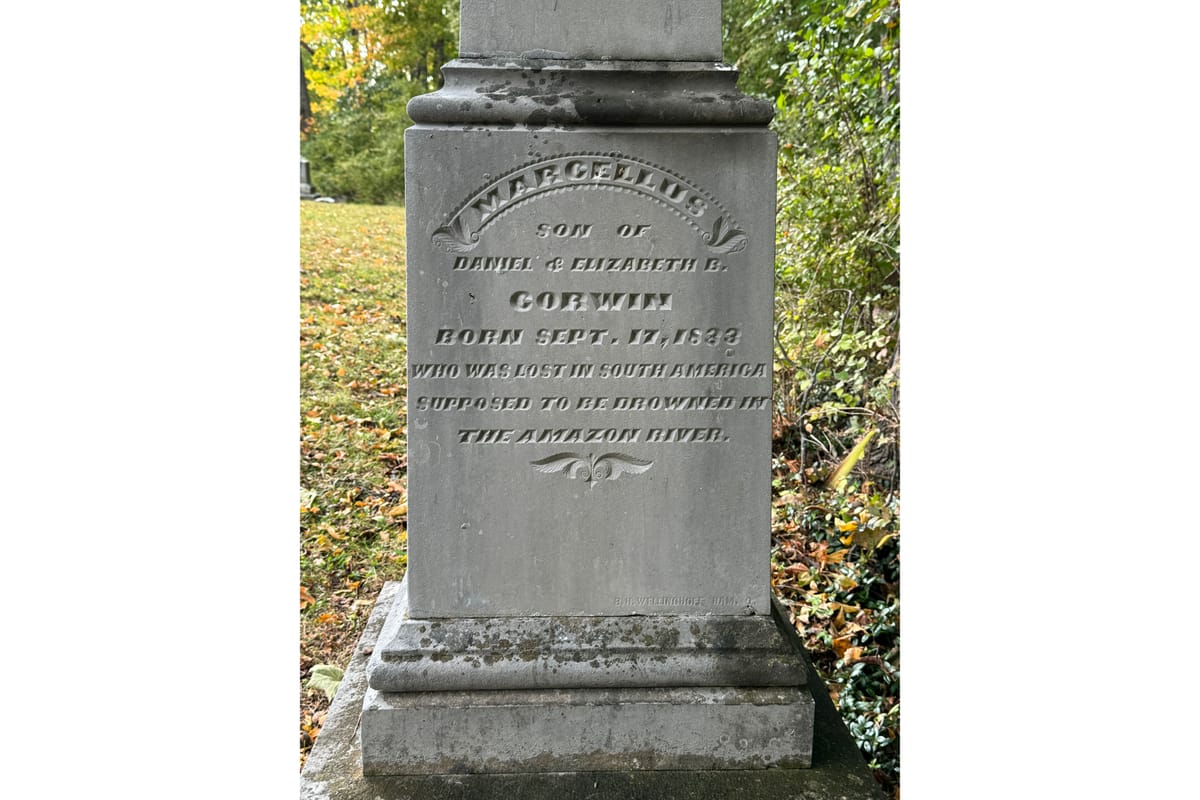Local Legends: A deadly adventure
Little is known about Oxford resident Marcellus Corwin, but his gravestone offers hints about the adventure that ended his life.

Sometimes, evidence of the past doesn’t fill in the gaps of history. This is the case with the life and mysterious death of local adventurer Marcellus Corwin.
Corwin was born on Sept. 17, 1833, but his birthplace is unknown.
His mother, Elizabeth B. Corwin’s headstone details that she was a native of Hartford, Connecticut, born on March 17, 1797, but little else is known about her. Even her maiden name, which is possibly Spinning, cannot be verified.
Evidence preserves more about Corwin’s father, Daniel W. Corwin. He was born in 1788 in New Jersey, possibly at Morristown. He took part in the large migration of New Jerseyans to Southwestern Ohio in the late 1700s and very early 1800s, bringing his family to Cincinnati sometime between 1811 and 1836.
The Corwins remained in Cincinnati for a while, rising to prominence in that city’s business community. In 1836, Daniel Corwin is listed in a Cincinnati city directory as a proprietor of Ellis & Corwin, wholesale dealers in dry goods. However, it's unknown if this entry is referring to Corwin’s father or older brother, as they were both merchants and shared the same name.
Daniel W. “D.W.” Corwin, Corwin’s older brother, married Harriet W. (Loring) Corwin in Cincinnati in 1838. His family appears in the 1850 Census and city directories from around the same period show that he was a co-owner of King, Corwin & Co. Dry Goods.
Corwin, listed as “Marsell” in the same census, is recorded as working as a clerk and living in the household of J.H. Jones. Two other probable relatives of unknown relation, John and Mary Corwin, lived with him in the same household. Directory evidence clarifies that he was employed at his brother’s business.
According to land conveyance records, Corwin’s father bought the family farm in Section 26 of Oxford Township on Nov. 3, 1851. As an unmarried young man, Corwin likely accompanied his parents to Oxford Township, but this cannot be confirmed. The 1882 “Cyclopedia of Butler County” mentions that Daniel Corwin also briefly owned the Mansion House, a tavern/hotel located at the southwest corner of Main and High Streets in Oxford.
The Gold Rush, which had started in 1849 and had drawn thousands away from home to California seeking gold, was in full swing in the early 1850s. Gold fever was in the air, and young Corwin seems to have caught it.
Instead of heading out to a West Coast oversaturated with prospectors, Corwin had another idea. He and a companion named Joseph Brashears, of Cincinnati, instead embarked on a gold seeking expedition to South America, leaving for the Amazon in 1853.
Newspapers ads and articles from that time period reported on an abundance of natural resources being present in the Amazon rainforest. These articles described a lush environment filled with gold, silver, diamonds, fertile soil, timber and medicinal herbs.
Records fall short of describing how the two men traveled to the Amazon, and how their trip was funded, but they almost certainly took a steamship for at least part of the journey to the continent. Another possibility is that they joined the expedition to the Amazon being led by a Captain Thomas, who was written about in a few regional newspapers in early 1853.
Rather than finding gold and riches, Corwin and Brashears would instead lose their lives. Corwin’s cenotaph in Oxford Cemetery states that he was “lost in South America supposed to be drowned in the Amazon River.”
The Aug. 9, 1855 issue of the Jackson Standard, from Jackson Courthouse, Ohio, offers more detail. The newspaper reports that Corwin and Brashears had been attempting to explore the gold regions at the source of the Amazon River when they and their party drowned while trying to cross the river’s streams.
The Jackson Standard article also says that the drowning had occurred about a year earlier and word of the incident had just been received from “recent advices from that country.”
Another interesting element to the story is a possible familial connection. Amos Breckinridge “A.B.” Corwin was the U.S. Consul to Panama in the early 1850s. No relationship between him and Corwin could be verified through research, although the possibility of a connection cannot be ruled out. The two Corwins existed in the same era, both lived in Cincinnati for a time, and they shared a common name and connection to South America.
In 1855, when the Oxford Cemetery Association was first established, Corwin’s father sold a parcel of his land to the organization for the creation of Oxford Cemetery. He held onto the rest of the farm until 1865 when he sold it and moved to the Village of Oxford.
Corwin’s mother died in 1867 and now shares a headstone with their son’s cenotaph in the cemetery partially located on the land the family once owned. Corwin’s father followed her to Oxford Cemetery after his death in 1875.
Although there are many elements to Corwin’s story that are missing or unclear, the historical evidence does exist tells a compelling tale about a young adventurer seeking his fortune in an untamed wilderness. It could almost be the opening to a work of fiction, if it wasn’t a true story.
Brad Spurlock is the manager of the Smith Library of Regional History and Cummins Local History Room, Lane Libraries. A certified archivist, Brad has over a decade of experience working with local history, maintaining archival collections and collaborating on community history projects.




